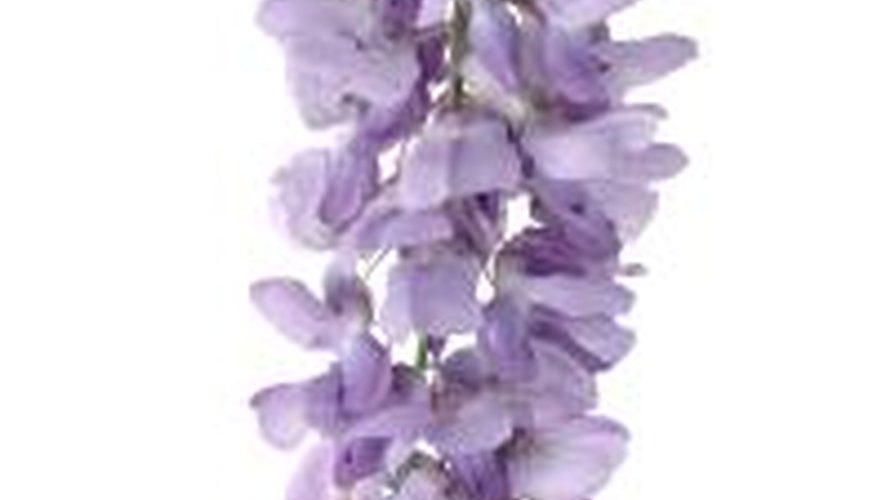Two species of wisteria produce prolific displays of flowers in spring before their leaves appear: the Japanese wisteria (Wisteria floribunda) and the Chinese wisteria (W. sinensis). In American landscapes, gardeners monitor the growth of both species, as they often become overly vigorous or weedy. Also flowering in late spring or very early summer, but after the leaves appear, are the native American wisteria (W. frutescens) and Kentucky wisteria (W. macrostachya). Both rebloom sporadically across the summer and fall.
Flowering Time
Don't expect reflowering on the Japanese and Chinese wisteria vines as late as August -- they bloom anytime from late March into late May. Slow-to-develop flower buds may lag behind the springtime flowering display, perhaps opening into early June. The native North American wisterias naturally bloom about a month later than the Asian wisteria species. Occasional flower clusters, called racemes, continue to appear in irregular number or timing into July, August or September.
- Don't expect reflowering on the Japanese and Chinese wisteria vines as late as August -- they bloom anytime from late March into late May.
- Slow-to-develop flower buds may lag behind the springtime flowering display, perhaps opening into early June.
- Occasional flower clusters, called racemes, continue to appear in irregular number or timing into July, August or September.
Types of American Wisteria
In its native habitat, American wisteria vines grow in moist or wet woodlands, along river banks or in sunny thickets across parts of the U.S. east of the Mississippi River. They survive the winters in U.S. Department of Agriculture plant hardiness zones 5 through 9. Cultivars frequently sold in garden centres include Amethyst Falls and Nivea, the latter being a white-flowering selection. The Kentucky wisteria demonstrates better winter cold resilience, surviving winters even in USDA zones 3b and 4. Kentucky wisteria grows in similar habitats as the American wisteria, but naturally inhabits only a smaller section of the Southeast. Blue Moon, Aunt Dee and Clara Mack are cultivars of Kentucky wisteria.
- In its native habitat, American wisteria vines grow in moist or wet woodlands, along river banks or in sunny thickets across parts of the U.S. east of the Mississippi River.
- Kentucky wisteria grows in similar habitats as the American wisteria, but naturally inhabits only a smaller section of the Southeast.
Care of Wisteria
To enjoy flowers on any species of wisteria, do not prune at the wrong time of year, as they produce flower buds on "old wood" -- the woody stems that grew the previous year. Asian wisteria vines, with their more rampant growth, tend to need annual pruning to keep them at a tidy and more manageable size. Always prune wisterias immediately after the main flowering season ends. This allows ample time for new growth to mature before fall. Do not prune wisteria vines, including native American species, past midsummer. Late pruning removes woody tissues that produce flowers next year.
- To enjoy flowers on any species of wisteria, do not prune at the wrong time of year, as they produce flower buds on "old wood" -- the woody stems that grew the previous year.
Promoting Good Flowering
Regardless of species, wisteria vines flower best when planted in sunny garden settings. Anywhere from four to 12 hours of direct sun daily suffices. Too much shade inhibits flowering. Also do not overfertilize, especially with a formulation rich in nitrogen. Nitrogen promotes leafy growth at the expense of blossoms.
- Regardless of species, wisteria vines flower best when planted in sunny garden settings.
